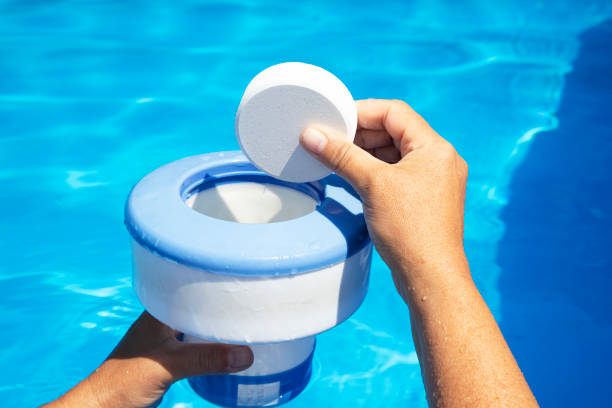5 Common Salt Water Pool Problems and How to Fix Them
Saltwater pools are popular among homeowners for their gentler water and lower chemical use compared to traditional chlorine pools. With a pool saltwater system, maintenance can feel more manageable and less abrasive. However, despite these advantages, saltwater pools come with their own unique set of challenges that can be difficult to navigate without proper knowledge and care. In this article, we’ll explore five common saltwater pool problems and how to fix them, helping you stay on top of your pool maintenance in Lewisville and keep your water sparkling clean.
High Salinity Levels
Symptoms: Irritated skin, salty taste, or corrosion of metal parts around your pool.
Cause: One of the most common issues with a saltwater pool is having too much salt in the water. This can happen if the pool is over-salted or if salinity levels are not monitored regularly.
Solution:
- To fix high salinity levels, the first step is to test the salt levels with a saltwater pool test kit. The ideal salinity range for a saltwater pool is between 2,700 and 3,400 ppm (parts per million).
- If the salt levels exceed this range, partially drain the pool and refill it with fresh water to dilute the excess salt.
- Consistent testing and careful monitoring will help prevent over-salting in the future.
Regular maintenance ensures that high salinity levels don’t lead to larger issues like damage to the pool’s structure or irritation to swimmers.
Chlorine Generator Failure
Symptoms: Cloudy water, algae growth, or persistently low chlorine levels.
Cause: A chlorine generator, also known as a salt cell, is responsible for converting salt into chlorine. When it fails, you’ll notice that your pool water turns cloudy, algae starts to bloom, or your chlorine levels drop too low. Often, this failure is caused by calcium buildup on the generator plates, which hampers its ability to function.
Solution:
- Start by cleaning the salt cell using a mixture of water and acid or a specialized cell cleaning solution. This will help remove calcium buildup.
- If cleaning doesn’t work, inspect the salt cell for wear and tear. Older or heavily used systems may require replacement parts.
- Be sure to monitor your chlorine levels regularly to ensure that the salt cell is functioning properly.
Routine cleaning and inspections of the chlorine generator can extend its lifespan and prevent more serious maintenance issues down the line.
pH Imbalance in Salt Water Pools
Symptoms: Scaling on pool surfaces, skin irritation, and cloudy water.
Cause: A pool salt water system can affect the pH of the water. Saltwater pools tend to have a higher pH due to the chemical reactions involved in the salt-to-chlorine conversion. If the pH is not balanced correctly, it can lead to skin irritation for swimmers, scaling on the pool surfaces, and cloudy water.
Solution:
- Test the pH levels regularly. The ideal pH for saltwater pools is between 7.2 and 7.6.
- If the pH is too high, add a pH reducer (muriatic acid or sodium bisulfate) to bring it down. If it’s too low, use a pH increaser (sodium carbonate).
- Additionally, check the pool’s total alkalinity, as it affects the stability of pH levels. Maintaining proper alkalinity will make it easier to keep the pH in check.
Balancing pH is essential for ensuring the comfort of swimmers and preventing damage to the pool’s surfaces and equipment.
Calcium Buildup on Surfaces
Symptoms: White scaling on tiles, pool walls, or around metal equipment.
Cause: Saltwater pools, especially those with hard water, are more prone to calcium buildup. This scaling can form on the pool’s surfaces and equipment, leading to a rough, unsightly texture and potential damage.
Solution:
- Use a calcium sequestrant to prevent calcium from forming hard deposits on your pool surfaces.
- For existing buildup, clean the affected areas using a pumice stone or a vinegar-based solution. Be gentle to avoid scratching the surfaces.
- Test and monitor the pool’s calcium hardness regularly, keeping it in the recommended range of 200–400 ppm to avoid further buildup.
Managing calcium hardness levels will help keep your pool looking great and extend the life of your equipment.
Cloudy Water
Symptoms: Poor visibility and murky, dull-looking water.
Cause: Cloudy water is a common problem in saltwater pools and can be caused by poor filtration, a chemical imbalance, or a dirty salt cell.
Solution:
- First, check your pool’s filtration system to ensure it’s running correctly. Clean or backwash the filter as needed.
- Shock the pool with chlorine to rebalance the water chemistry and clear up any murkiness.
- Clean the salt cell, as a dirty cell may fail to produce enough chlorine, leading to cloudy water.
- Lastly, check all chemical levels and adjust them as necessary, including pH, chlorine, and alkalinity.
By maintaining a clean filtration system and keeping chemicals balanced, you can prevent cloudy water and ensure a clear swimming environment.
Ensure Your Salt Water System is in Pristine Condition
Owning a saltwater pool comes with many perks, but it’s important to be aware of potential challenges and stay proactive with regular maintenance. From salinity levels to chlorine generator issues, each of these common problems can be addressed with the right tools and knowledge. If you need help with pool maintenance in Lewisville or require expert advice on handling more complex issues, don’t hesitate to consult a professional. With proper care, your saltwater pool will remain a refreshing and enjoyable part of your home for years to come.
Keep an eye for more latest news & updates on Discover Tribune!






